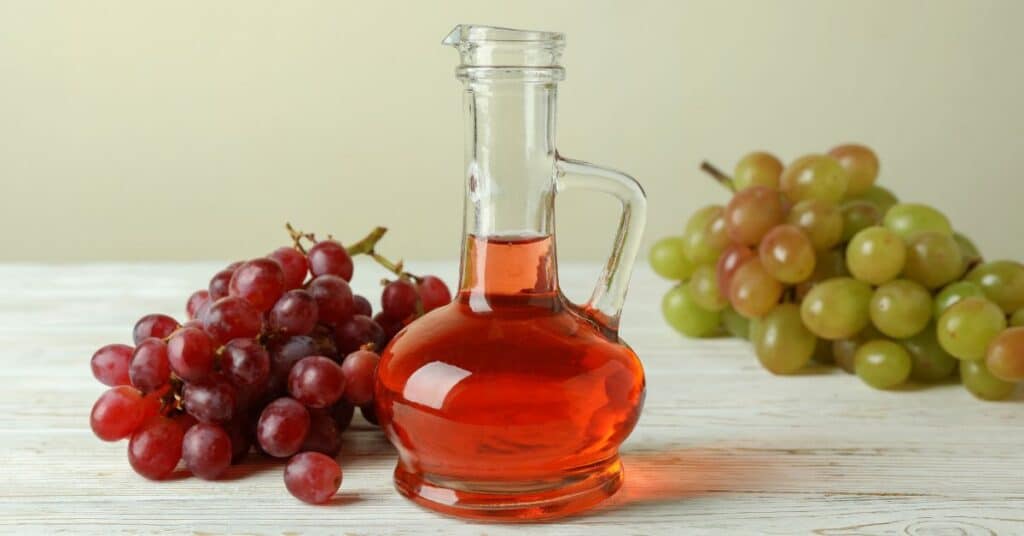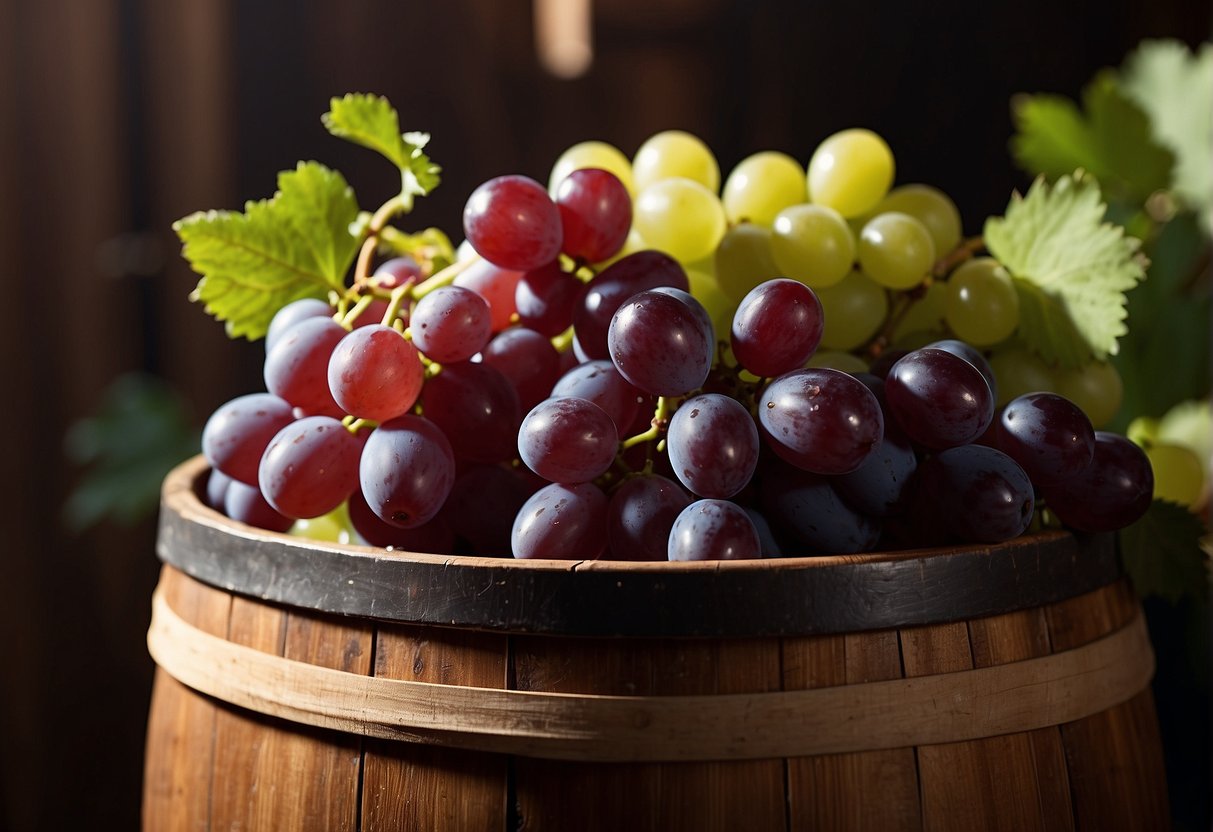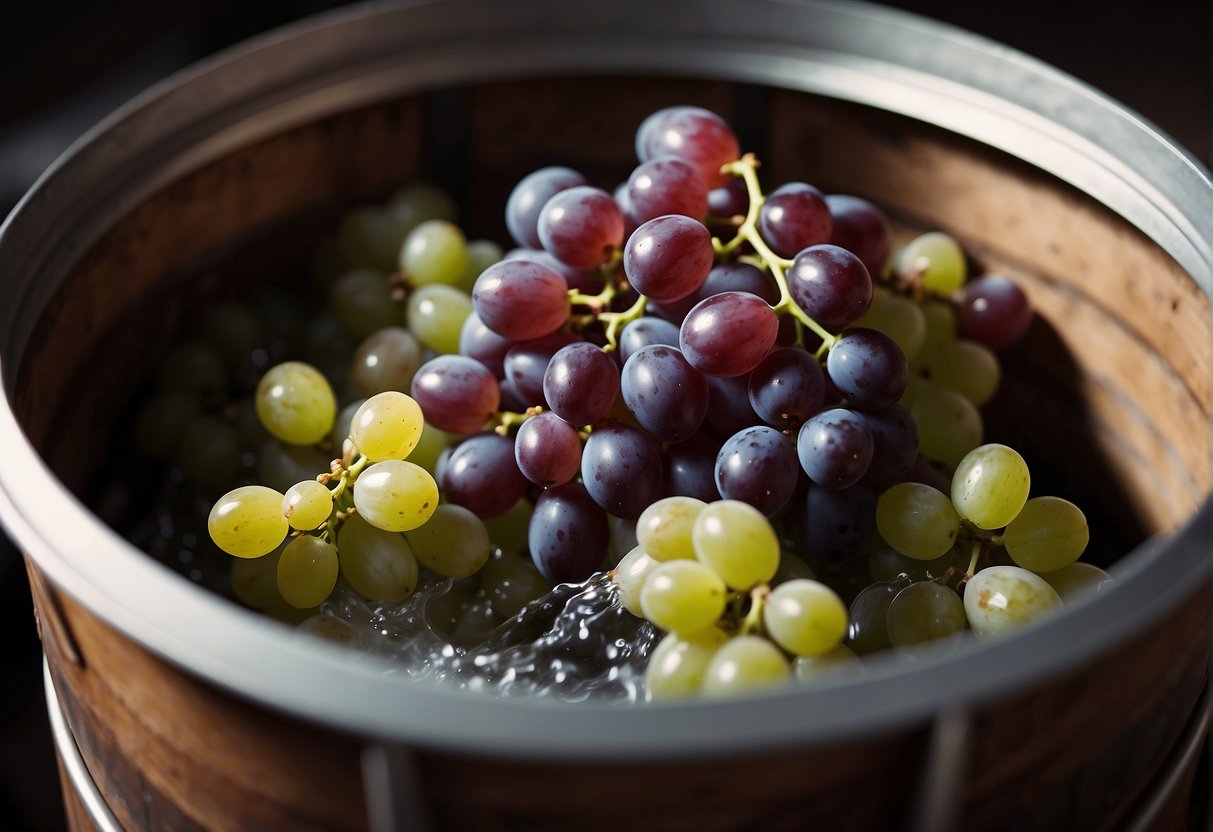
Making vinegar from grapes is an age-old practice that transforms simple fruit into a versatile kitchen staple. The process not only unlocks a world of culinary uses but also carries an element of tradition that’s been passed down through generations. Creating your own grape vinegar can be a rewarding journey, offering control over taste, acidity, and quality.

The journey begins with selecting the right grapes—sweet and ripe for a natural fermentation process. Proper preparation of grapes, including crushing and juicing, will set the foundation for a successful transformation. As you embark on this adventure, your patience will be tested through fermentation and aging, but the end product will be a personalized touch to your cooking arsenal.
Key Takeaways
- Home-made grape vinegar enhances culinary flexibility with a personal touch.
- The process starts with selecting ripe, high-quality grapes.
- Patience during fermentation and aging is key to superior vinegar quality.
Selecting the Right Grapes

When making vinegar, the quality of your end product is largely influenced by the grape variety you choose. Begin with fresh, high-quality grapes; aim for organic to avoid pesticides that could affect the fermentation process.
- Wine Grapes vs. Table Grapes:
- For a rich flavor, opt for wine grapes such as Cabernet Sauvignon, Merlot, or Chardonnay.
- Table grapes can also work, but the flavor might be less intense.
- Grape Condition:
- Use ripe, unbruised grapes to ensure natural sugar content, which is critical for fermentation.
- Avoid moldy or rotten grapes, as these can spoil your vinegar.
- Color Matters:
- Red grapes will produce a robust, full-bodied vinegar.
- White grapes result in a lighter, more delicate vinegar.
Here’s a summary chart for quick reference:
| Grape Type | Flavor Characteristic | Vinegar Type |
|---|---|---|
| Cabernet Sauvignon | Rich and robust | Full-bodied vinegar |
| Chardonnay | Crisp and fruity | Delicate vinegar |
| Table Grapes | Mild and sweet | Milder vinegar |
Remember to crush your grapes thoroughly to extract the juice; this is the first step in beginning your vinegar fermentation. Happy vinegar-making!
Preparing the Grapes

To ensure a successful vinegar fermentation, start with fresh, ripe grapes, meticulously cleaned and correctly prepared.
Washing and Crushing
First, wash your grapes to remove any pesticide residue or dirt. Gently rub the grapes under cool, running water and pat them dry with a clean towel. Once cleaned, crush the grapes to release the juice. You can do this using a grape crusher if available, or by lightly mashing them in a clean container using a sanitized masher or your hands.
- Equipment:
- Grape crusher or masher
- Clean container
- Towel
Sanitization
Sanitize all equipment that will come into contact with the grape juice to prevent contamination. Use a food-grade sanitizer and follow the manufacturer’s directions for proper use. Rinse the equipment with clean water after sanitization to ensure no residual sanitizer remains.
- Steps:
- Dilute food-grade sanitizer as directed.
- Soak or wipe equipment with the solution.
- Rinse thoroughly with clean water.
Fermentation Process

The transformation of grapes into vinegar involves two key stages of fermentation, where sugars are first turned to alcohol and then to acetic acid.
Primary Fermentation
During primary fermentation, yeast converts the natural sugars in grape juice into ethanol (alcohol) and carbon dioxide. To begin, you’ll need:
- Fresh grapes
- A clean fermentation vessel
- Yeast (wine yeast is preferable)
Steps:
- Crush your grapes to release the juice.
- Transfer the juice to your fermentation vessel.
- Add wine yeast to the vessel. For every gallon of grape juice, use about 5 grams of yeast.
- Cover the vessel with a cloth or fermentation lock to allow gases to escape but prevent contaminants.
Allow the mixture to ferment at room temperature (around 70°F) for about 10-14 days. You’ll know the primary fermentation is complete when bubbling activity significantly decreases.
Secondary Fermentation
In secondary fermentation, bacteria (Acetobacter species) oxidize the alcohol into acetic acid, which gives vinegar its sour taste. To ensure a successful conversion:
- Use a mother of vinegar or raw, unfiltered vinegar as an inoculant.
- Provide oxygen access, as the bacteria need it to function.
Procedure:
- After primary fermentation, transfer the alcohol into a wide-mouthed vessel to increase oxygen exposure.
- Introduce the mother of vinegar into the vessel at a ratio of one part mother to ten parts alcohol by volume.
- Cover with a breathable cloth tightly secured around the vessel.
Keep the vessel in a dark place at a temperature range between 60°F and 80°F and let it sit for several weeks to several months, checking periodically until the desired acidity is reached.
Aging and Bottling

After your grape juice has fermented into vinegar, it’s time to age and bottle your product to enhance its flavor and quality.
- Aging Your Vinegar:
- Find a cool, dark place to store your vinegar, ideally between 60-80°F (15-27°C).
- Age in glass, stainless steel, or wood containers as these won’t react with the acid.
- If aging in wood, use oak barrels which impart a rich flavor.
- Allow the vinegar to age for at least 2 months. For more complex flavors, aging can last up to 2 years.
- Taste periodically to monitor development.
- Bottling:
Step Description 1. Prepare Bottles: Sanitize glass bottles using boiling water or a sterilizing solution. 2. Filtration (Optional): For clearer vinegar, filter through cheesecloth or a coffee filter. 3. Filling: Use a funnel to pour vinegar into bottles, leaving some headspace at the top. 4. Sealing: Secure the bottle with a tight cap or cork to prevent contamination and oxidation.
- Label each bottle with the type of vinegar and date bottled.
- Store bottled vinegar in a cool, dark place to preserve quality.
Remember, patience is key in aging, as it allows the flavors to deepen and mature. The bottling process should be done meticulously to maintain vinegar’s character and prevent spoilage. Enjoy the fruits of your labor by using your homemade vinegar in dressings, marinades, or as a condiment.
Frequently Asked Questions

In this section, you’ll find answers to questions about making homemade grape vinegar, from the basic steps to health benefits and traditional recipes.
What are the steps to create homemade grape vinegar?
To make homemade grape vinegar, start by crushing fresh grapes and collecting the juice. Allow natural fermentation by leaving it at room temperature for 2-3 weeks, covered with a cheesecloth. Once alcohol forms, add vinegar mother to the mixture, and let it ferment for several more weeks until it acquires a tangy taste.
Can you explain the process of turning grape juice into vinegar?
The process is a two-stage fermentation. First, yeast turns the grape juice’s sugars into alcohol, creating wine. In the second stage, acetic acid bacteria convert the alcohol into acetic acid, resulting in vinegar. Ensure a steady, warm environment and oxygen exposure for the bacteria to work effectively.
What are the health benefits of consuming red grape vinegar?
Consuming red grape vinegar can offer antioxidants due to the presence of polyphenols from the grapes. It may promote cardiovascular health and proper digestion. However, always consume it in moderation, as it is acidic and can affect tooth enamel and sensitive stomachs.
How does one cultivate ‘mother of vinegar’ when making grape vinegar?
Cultivating ‘mother of vinegar’ involves keeping a small amount of previous batch’s vinegar, in which the acetic acid bacteria colony thrives. Introduce this mother to your new batch after the alcoholic fermentation. With proper conditions—warmth and oxygen—the mother will ferment the alcohol into vinegar.
What’s the difference between balsamic vinegar and grape vinegar?
Balsamic vinegar originates from Italy and undergoes a complex process involving aging grape must in wooden barrels for years. Grape vinegar is less complex, made by fermenting grape juice or wine. Balsamic has a richer, sweeter flavor, while grape vinegar is more acidic and sharp.
Could you share a traditional recipe for making Turkish grape vinegar?
For Turkish grape vinegar, select high-quality, ripe grapes. Crush them and strain the juice into a large container. Allow it to ferment into wine over 2-3 weeks, then introduce vinegar mother and let it ferment for 4 weeks more. For authentic flavor, use dark, sweet grapes and ensure a warm fermentation environment.
